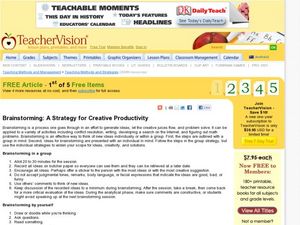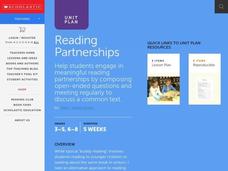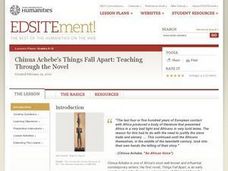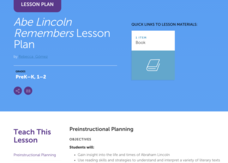Curated OER
Eating Healthy
Students review healthy eating habits, and demonstrate reading comprehension skills, including reading strategies, inference, literal meaning, and critical analysis.
Curated OER
Brainstorming: A Strategy for Creative Productivity
In this brainstorming activity, students read directions on how to brainstorm with a group or as an individual. Students read 7 tips total.
Curated OER
Teaching Imagery with Gary Paulsen
Students read excerpts from memoirs written by Gary Paulsen as examples of how to write a narrative piece. They identify figurative language used and then they write a memoir of their own that contains imagery and figurative language.
Curated OER
Reading Partners
Students participate in several activities using a reading partner. They plan and organize reading meetings with their partner, and then review story elements by retelling the stories orally. The partners question each other and make...
Curated OER
Using Authentic Literary Text With Advanced Learners
Students practice reading for the gist of a text, improving reading speed, and fostering interest in reading authentic texts. They explore the use of figurative language.
Curated OER
Fever 1793: Anticipation Guide
Introduce the themes of Fever 1793 and determine your class members’ level of background knowledge with an anticipation guide for Laurie Halse Anderson’s novel about the yellow fever epidemic that swept Philadelphia. For each prompt,...
Curated OER
Chinua Achebe's Things Fall Apart: Teaching Through the Novel
Students are introduced to Chinua Achebe's first novel and to his views on the role of the writer in his or her society. It can be used alone or in conjunction with the related lesson Chinua Achebe's Things Fall Apart.
Curated OER
The Kite Runner: Amir Debate
Does Amir have an obligation to find Sohrab and take him to the orphanage? That is the question class members debate as part of their reading of Khaled Hosseini's The Kite Runner.
Lerner Publishing
Teaching Habitats
What makes up a habitat? Use this resource to engage first graders in the exploration of desert, wetland, forest, and ocean habitats. Youngsters classify plants and animals into the four distinct habitats through drawings and cutting and...
Curated OER
Dandelion Wine: Questioning Strategy
Readers of Dandelion Wine work in groups to develop questions on four levels (right there, think and search, the author and you, and on my own) about Chapter 34 of Ray Bradbury's reflection on the joys of summer. Groups jigsaw and then...
Lerner Publishing
Teaching Folklore
Wonderful worksheets and activities complementing six sequential lessons are what you'll find in this unit on folklore. Pupils create folktales using literary devices and included story starters, compare and contrast different folklores,...
Scholastic
Abe Lincoln Remembers Lesson Plan
Discover the life of Abraham Lincoln with help from the story Abe Lincoln Remembers by Ann Turner. After listening carefully, scholars reflect on what they deem as Lincoln's most influential life event and how it relates to them,...
Curated OER
Hear Ye, Hear Ye: Read All About It!
Develop an online newspaper covering the Lewis and Clark Expedition. The class publishes their newspaper on the school's Web site and analyze both primary and secondary sources.
EngageNY
Using Informational Text Features and Learning Freaky Frog Vocabulary
What kind of text features help children build a strong vocabulary? Class members use text features such as headers to unpack new vocabulary words. They create vocabulary journals in which they will write what they think the definition...
American Museum of Natural History
What's This? Reproduction
Attracting the right mate is as important for humans as any other species. An interesting lesson teaches individuals about several strategies that animals and plants have adapted to attract their mates. From colorful nests to powerful...
Curated OER
The Jungle Book Teacher's Notes
Rudyard Kipling's The Jungle Book is a childhood classic that readers of all ages enjoy. A teaching packet that includes instruction tips, comprehension strategies, background information on the book and author, and two fun worksheets.
Teaching Tolerance
Where We Stand
Everyone is entitled to their own opinion. Academics learn strategies to share their opinions and agree or disagree with others in a respectful manner. The resource provides scenarios to help individuals form opinions and share them with...
Scholastic
Follow the Clues
Invite your text detectives to bring their magnifying glasses to school to examine the clues in a text and make predictions. They write down three clues and a prediction on the graphic organizer.
EngageNY
Organizing an Opinion, Reasons, and Evidence: Text 2 for Each Expert Group
The proof is in the reading. Using the informative resource, scholars read a second article about either Althea Gibson or Roberto Clemente. As they read, they continue adding reasons and evidence to their graphic organizers to show how...
EngageNY
Using Effective Search Terms: Researching Screen Time
The proof is in the reading. Scholars read an article, "Attached to Technology and Paying the Price," and answer text-dependent questions. Next, they complete a Venn diagram to contrast two authors' use of evidence on the topic of screen...
EngageNY
Analyzing, Comparing, Sharing: Modern Voices
What do modern voices sound like? Scholars explore the topic, reading two concrete poems from John Grandit's Blue Lipstick and analyzing them using a graphic organizer. Next, they read a third poem and work with partners to look for...
EngageNY
Organizing an Opinion, Reasons, and Evidence: Text 1 for Each Expert Group
Working in small groups, scholars continue reading an informational text about either Roberto Clemente or Althea Gibson. As they read, pupils create graphic organizers in their journals to help map their ideas logically.
EngageNY
Organizing an Opinion, Reasons, and Evidence: Expert Group Text 3
Let's race to the finish line. Scholars read an informational text about a chosen athlete. While reading, they add evidence and reasons to a graphic organizer to support their opinions about how their athlete broke barriers.
Health Smart Virginia
How the Namuhs Learned to Be Content with Who They Are
Ninth graders consider how perceived standards of beauty influence body image as well as the relationship between body image and eating disorders. The class brainstorms traits the media presents as beauty standards for males and females,...

























